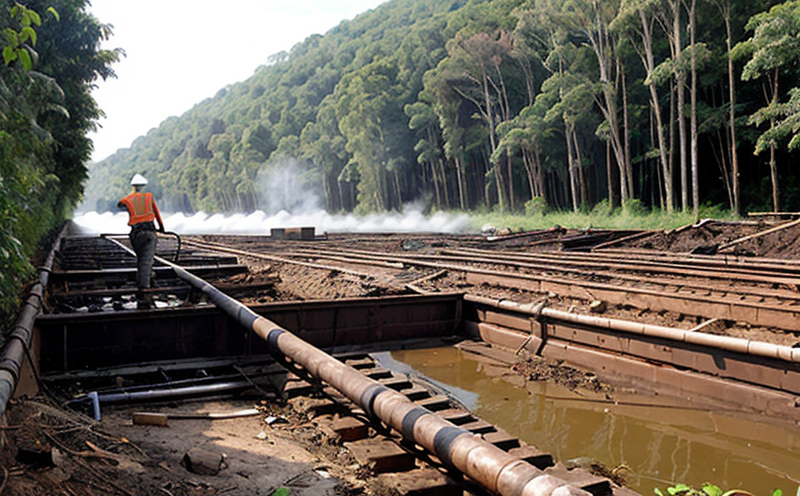ASTM E1527 Phase I Environmental Site Assessment Audit Test
The ASTM E1527-13[1] Phase I Environmental Site Assessment (ESA) audit is a critical tool for identifying potential environmental risks associated with real property. This assessment serves as the foundation for understanding current and historical uses of the site, which can inform decisions regarding future development, remediation efforts, or compliance with regulatory standards.
The process involves a comprehensive review of available records, interviews with knowledgeable parties, and field inspections to gather pertinent information about the property. Key components include:
- Historical land use and environmental activities
- Potential contamination sources such as petroleum products, hazardous waste materials, or other chemicals
- Site-specific characteristics relevant to environmental risk assessment
- Regulatory compliance status
The goal is to produce a Phase I ESA report that provides a clear picture of the site's environmental history and any potential liabilities. This document acts as an essential reference for stakeholders, including property owners, lenders, tenants, and regulatory agencies.
When conducted by accredited laboratories, this assessment ensures the highest level of accuracy and reliability. Accreditation guarantees adherence to strict quality control procedures and standards set forth by relevant authorities such as ISO/IEC 17025[2].
This service is particularly valuable for organizations operating in sectors where environmental risk management is paramount, including commercial real estate, industrial facilities, and manufacturing plants. For instance, a Phase I ESA can help identify historical petroleum releases that might require remediation under the Comprehensive Environmental Response, Compensation, and Liability Act (CERCLA), also known as Superfund.
The assessment process typically begins with a site visit during which the assessor interviews current and former property owners, operators, or managers. They review documents such as environmental permits, spill reports, and any other records that could provide insight into past activities.
Following the interview phase, field investigations may involve visual inspections of the property's exterior, investigation wells, and sampling from various locations on-site if necessary. These samples are then sent to accredited laboratories for analysis according to appropriate methods like ISO 17025.
The final report summarizes all findings and includes recommendations based on the data collected. It serves as a valuable resource for decision-makers who need objective information about environmental risks before proceeding with transactions or projects involving the property.
It is important to note that while Phase I ESAs do not involve sampling or testing of soil, water, or air, they provide crucial context that can inform subsequent more detailed assessments if required. The accuracy and thoroughness of these initial evaluations directly impact the effectiveness of any follow-up actions taken.
Benefits
The ASTM E1527 Phase I Environmental Site Assessment Audit Test offers numerous advantages to organizations across various sectors. By providing a comprehensive overview of potential environmental risks, it helps mitigate financial and legal exposure related to contaminated properties.
- Financial Protection: Early identification of liabilities can prevent costly cleanups later down the line. This service ensures that buyers, sellers, or lenders have complete transparency regarding any existing issues.
- Regulatory Compliance: Compliance with environmental laws and regulations is crucial for maintaining good standing within regulatory bodies like EPA (Environmental Protection Agency).
- Informed Decision Making: Stakeholders gain valuable insights into the history of a property, enabling better strategic planning. This includes decisions related to redevelopment projects or simply choosing between competing offers.
For businesses involved in real estate transactions or those considering acquiring properties with complex histories, this assessment provides peace of mind by addressing uncertainties upfront. In essence, it bridges the gap between risk identification and strategic mitigation strategies, ensuring that all parties involved are well-informed before moving forward.
Industry Applications
- Commercial real estate developers looking to purchase or sell properties
- Industrial facilities assessing their current site for future expansion plans
- Manufacturing companies evaluating potential locations for new plants or warehouses
- Financial institutions reviewing loan applications involving potentially contaminated sites
Use Cases and Application Examples
A Phase I ESA can be tailored to meet the specific needs of different stakeholders depending on their goals. Here are some practical examples:
- Real Estate Transactions: A Phase I ESA conducted during a property purchase allows both buyer and seller to understand any potential environmental concerns associated with the sale.
- Facility Expansion: Before expanding operations into an existing facility, an assessment can reveal hidden contamination risks that would otherwise be overlooked.
- Corporate Due Diligence: Companies performing due diligence on acquisition targets use Phase I ESAs to ensure they are not inheriting unknown liabilities.





